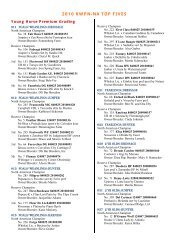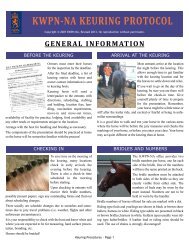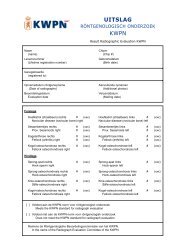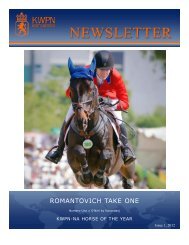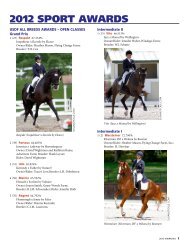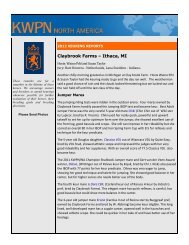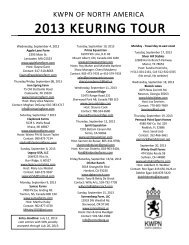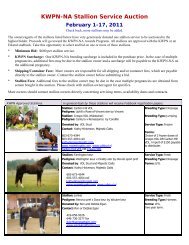Download PDF - KWPN
Download PDF - KWPN
Download PDF - KWPN
Create successful ePaper yourself
Turn your PDF publications into a flip-book with our unique Google optimized e-Paper software.
Summary<br />
1. Growing foals have a need for high nutrient density during the first<br />
few months of life<br />
2. Nutrient balance is critical to sound muscle and bone development.<br />
3. It is usually best to select a commercial concentrate that is designed for<br />
the age foal you are feeding and the forage you are supplementing.<br />
4. High quality forage is important for good nutrient balance and good<br />
digestion. You can feed a high quality grass, grass legume mixture or<br />
straight legume as long as the concentrate is formulated to provide<br />
proper nutrient balance.<br />
5. The nutrient needs of the growing horse decreases as he matures<br />
because his growth rate decreases.<br />
primary energy source. Sometimes we<br />
add one of the vegetable oils, corn,<br />
soybean or canola to boost the energy<br />
content. We use soybean meal or one<br />
of the other oil meals as a protein<br />
source. We use by-product ingredients<br />
such as wheat middlings, wheat bran,<br />
beet pulp, or rice bran as both an energy<br />
source and a protein source. We<br />
sometimes add chopped forage to the<br />
product to adjust the energy content<br />
and increase the palatability. Our minerals<br />
may be in inorganic or organic<br />
forms. And our vitamins natural or<br />
synthesized.<br />
on a 14% protein product. Be sure to<br />
keep the appropriate nutrient balance.<br />
Diluting a 16% protein product with<br />
oats to lower the protein content to<br />
14% may destroy the nutrient balance.<br />
See example 1 on page 8.<br />
Although this combination meets<br />
the protein needs of the animal, the<br />
calcium content is less than desired<br />
and the product actually provides a<br />
negative calcium/phosphorus ratio.<br />
The product is also low in zinc and<br />
probably several other trace minerals<br />
and vitamins. Purchase a 14% product<br />
that is properly supplemented.<br />
Two and three year olds<br />
As the animal matures his rate of<br />
growth decreases. This means that the<br />
nutrient density of the diet can also<br />
decrease. It doesn’t mean that each<br />
nutrient is any less important, only that<br />
the amounts needed are easier to provide.<br />
A 10 or 12% protein concentrate<br />
is usually adequate depending upon<br />
the protein content of the forage. If<br />
you feed enough concentrate to maintain<br />
good body condition the nutrients<br />
in a balanced concentrate will support<br />
good muscle and bone development. If<br />
the animal is put in training, increased<br />
nutrient intake is recommended.<br />
Managing the feeding<br />
program<br />
In most situations we recommend<br />
commercial concentrates designed to<br />
be fed to the animal group listed<br />
above. In some locations, the availability<br />
of appropriate products is limited.<br />
This may make it necessary to formulate<br />
and mix your own feed on the<br />
farm. The largest challenge is to determine<br />
the nutrient levels you need and<br />
then finding appropriate feed ingredients<br />
and supplements to provide those<br />
nutrients. Horses will accept a large<br />
variety of ingredients, so it is our<br />
responsibility to select those that provide<br />
the nutrients in highly palatable<br />
and digestible form. In this country, a<br />
concentrate for a growing foal in<br />
Florida may be considerably different<br />
from one formulated in California due<br />
to ingredient availability and cost. In<br />
Europe, a concentrate formulated in<br />
Great Britain will likely be different<br />
from one formulated in Germany,<br />
France or Italy. In most areas we use<br />
feed grains, oats, barley, or corn as a<br />
PROBLEM BREEDERS<br />
Continued from Page 7.<br />
result of a poor perineal conformation,<br />
weak external genital barriers, or the<br />
presence of a low grade uterine infection<br />
introduced at the time of breeding.<br />
Pathological changes of the placenta<br />
can be detected by transrectal ultrasonography<br />
(Renaudin et al, 1997;<br />
Troedsson et al, 1997). An abnormal<br />
thickness of the uterus and the placenta<br />
(CTUP) at a site approximately 1-2<br />
inches cranial and lateral of the cervix<br />
has been associated with impending<br />
abortion (Troedsson et al, 1997).<br />
Separation of the allantochorion from<br />
the endometrium adjacent to the<br />
cervix is also indicative of placentitis<br />
and should be treated immediately.<br />
Page 9 • Newsletter





